Every Point is not Equal
- Shum
- Aug 14, 2022
- 2 min read
This is a post about leverage.
First, let me tell you about a winter routine I have with one of my best friends. His name is Steve.
Steve and I love to play squash.
We play weekly, usually on a weekend, starting around October (when golf season ends - Steve is a golfer) and ending around April (when golf season begins - Steve is actually a great golfer).
Over the years, we have invented our own way of scoring our games, so when we play, our games are played to 21 points.
Side note: Playing squash isn’t a prerequisite for understanding the point of this post.
Let’s imagine a hypothetical weekend with Steve, where we play a total of five games.
Note: There’s about to be a tiny bit of math below, so if you’re not a math person (p.s. anyone can be a math person, but that’s for another day) then fasten your seatbelts because there’s a tiny bit of light turbulence ahead.
Here are the hypothetical results from our hypothetical weekend match:
Game 1: Steve wins 21 - 18
Game 2: Steve wins 21 - 19
Game 3: I win 21 - 17
Game 4: Steve wins 21 - 18
Game 5: Steve wins 21 - 19
Now for the math:
Total points played: 196
Total points won by Steve: 101 (51.5%)
Total points won by me: 95 (48.5%)
Summary: Steve won 6 points more than I did, which amounts to 3.1% of the total points played.
Total games played: 5
Total games won by Steve: 4 (80%)
Total games won by me: 1 (20%)
Summary: Steve won 80% of the games we played.
Final summary: By winning 3.1% more points, Steve won 80% of the games.
Seatbelt sign off. Math over.
Clearly, not every point is equal.
Where I find this analogy most applicable is thinking about hours in a day.
You’ve got 24 of them.
3.1% of that is roughly 45 minutes.
How you spend that time, could change everything about your day.




Comments